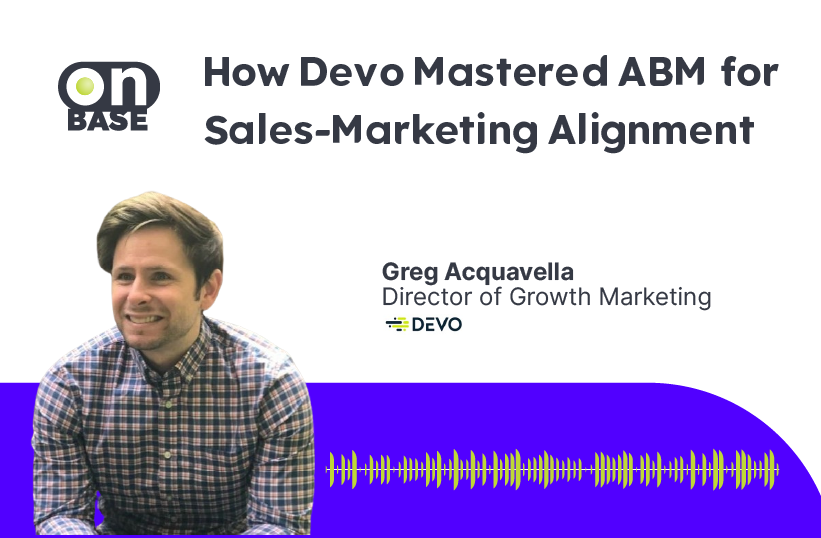Shownotes
This episode discusses how buyer behavior is changing, especially in manufacturing, and the challenges companies face in aligning their sales and marketing strategies as a result. The guest, Kathy Macchi, shares her insights from over 25 years in the industry on how buyers are younger and want more control over the process. She highlights culture, technology, and data silos as major barriers for manufacturing companies looking to align. The discussion covers how account-based marketing (ABM) can help manufacturers by prioritizing the right accounts for large deals and providing a framework for collaboration. They emphasize starting simple with ABM and having a dedicated sales leader champion the approach.
Best Moments
-
Kathy shares her experience with the challenges of outdated technologies like pagers and compares it to countries that adopted cell phones without legacy infrastructure
-
Chris emphasizes that changing culture requires a confident, courageous leader who is willing to take risks
-
Kathy discusses the underestimation of resources and time needed to drive major changes in sales and marketing alignment
-
Kathy highlights the importance of having a dedicated sales leader who continually reinforces the new ABM approach with their team
About the guest
Kathy has thrived through 25 years in sales, marketing, and IT, and now leads Inverta’s consulting. She takes a no-nonsense approach to the role of digital skills, processes, and tools, and has helped Citrix, Microsoft, and HP transform their marketing. Additionally, she’s one of the foremost authorities in account-based marketing and has been certified by ITSMA as an ABM practitioner since 2007. Kathy conducts workshops, webinars, and training sessions, and has supported hundreds of ABM rollouts and scale-ups. When Kathy isn’t traveling the world, she enjoys a top-shelf vegetarian breakfast taco at her home in Austin, TX.
Key takeaways
- Buyer behavior is changing, with younger buyers wanting more control over the sales process
- Major challenges for manufacturing companies in aligning sales and marketing include cultural resistance, lack of digital tools, and data silos
- ABM can help manufacturers target the right accounts for large deals, select key messages, and implement supporting technology
- When getting started with ABM, companies should pick the right sales leader, start simply, focus on goals and measurement, and continually reinforce the approach with sales
Quotes
“Buyer behavior is changing, they’re no longer an individual buyer like you used to have, it’s a buying group, and a lot of that buying group is anonymous.”
-Kathy Macchi
Highlights from this episode
How are buyer behaviors starting to change in manufacturing and what challenges does this pose for traditional sales strategies?
Kathy says buyer behavior is changing significantly even in manufacturing. She notes buyers are no longer individual decision makers, but rather buying groups, and the buyer now decides if and when they want to engage with sellers. She also points out buyers are getting younger on average.
This poses challenges for traditional sales strategies that rely on close relationships with individual buyers. Sellers now need to engage buying groups and be available on the buyers’ terms rather than controlling the process. Younger buyers may also expect more digital and self-service options that traditional manufacturing sales teams aren’t set up to provide.
How does account-based marketing help with those huge deals in manufacturing?
Kathy provides a few ways that account-based marketing (ABM) can specifically help manufacturing companies pursue those large, strategic deals:
- ABM acts as a forcing function to get sales, marketing, finance, and other teams aligned on prioritizing the right accounts with the most potential for big deals.
- It shifts marketing messaging from being product-focused to more customer-centric, which is important for large deals.
- ABM enables automating integrated sales and marketing strategies through technology, which is difficult without the right tools.
- By focusing on key accounts, ABM helps manufacturers build the reputation, relationships, and revenue needed to win deals that can be worth billions in revenue over long contracts.
What would you say to manufacturing companies about how they should approach getting started with ABM?
Kathy recommends manufacturing companies take a simple, low-risk approach when first getting started with ABM:
- Start with a small pilot rather than trying to implement everything at once. Focus on learning as you go.
- Pick the right sales leader to champion ABM – someone willing to work differently and collaborate across teams.
- Get sales, marketing, and other teams to agree on a shared list of target accounts to focus on.
- Set clear and measurable goals for what success looks like in the short term (3-6 months) to keep everyone accountable.
- Expect that goals and processes may need to evolve – don’t get bogged down trying to plan for every possibility upfront.
- Make sure the sales leader continually communicates to their team about how working methods are changing and reinforces the new approach.
What are some of the challenges you see for manufacturing companies in bringing together sales and marketing and starting an account-based strategy?
Some of the key challenges Kathy sees for manufacturing companies in bringing together sales and marketing to start an account-based strategy include:
- Cultural differences between the typically product-focused marketing teams and relationship-focused sales teams. This can lead to resistance to change.
- Lack of integrated data and technology platforms to support collaboration. Data is often held in silos.
- Sales teams not being accustomed to or comfortable with more digital and automated lead generation approaches.
- Marketing typically focuses on large strategic clients and branding, rather than the day-to-day needs of sales.
- Unclear how an account-based model would integrate with existing channel partner strategies.
- General lack of experience cross-functionally aligning sales and marketing at the level required for a strategic account-based approach.
- Underestimating the resources and time commitment needed to overhaul existing go-to-market processes and drive real alignment between teams.
Resource recommendations
Books
Podcast
–The Artificial Intelligence Show
Shout-outs
–Scott Vaughan, Chief Market Officer: GTM Executive and Advisor to CXOs & Teams
–Christopher Penn, Co-Founder and Chief Data Scientist at TrustInsights.ai
–Paul Roetzer, Founder & CEO at Marketing AI Institute

OnBase
Bridging the Divide, Between Sales and Marketing




